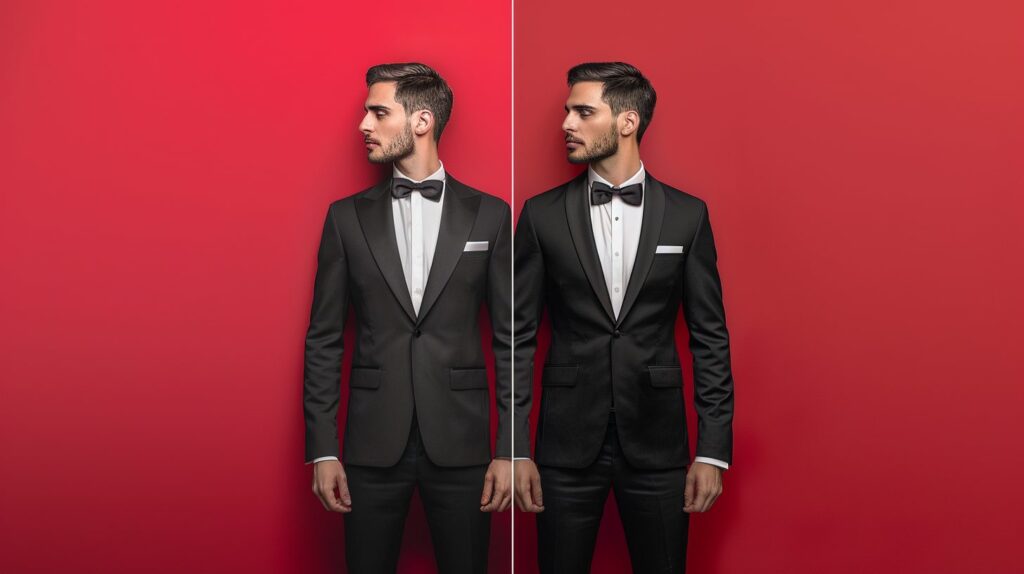A tuxedo, with its satin lapels and formal details, is perfect for black-tie events like weddings and galas, while a suit offers more flexibility for business or less formal occasions. Understanding the key differences between these two helps you dress appropriately and stand out for the right reasons. This quick guide will clear up the confusion, showing you when and how to wear each with style and ease.
What is a Tuxedo?
A tuxedo is a formal outfit worn for special occasions, like weddings, galas, and black-tie events. It usually includes a jacket with satin lapels, satin stripes down the trousers, and is paired with a formal shirt, bow tie, and shiny dress shoes. Tuxedos are made to look elegant and polished.
Different Types of Tuxedos
Classic Tuxedo
Black jacket with satin peak lapels, paired with a bow tie and a cummerbund for a traditional formal look.
Modern Tuxedo
Features a slimmer fit, may have shawl collars, and often comes in midnight blue for a stylish update.
White Dinner Jacket
A white tuxedo jacket, ideal for warm climates or summer events, offering a fresh and elegant alternative.
What is a Suit?
A suit is a more versatile outfit that can be worn for business, events, or casual gatherings, depending on how it’s styled. It includes a jacket and matching trousers, often with a shirt and tie.
Different Types of Suits
Business Suit
Typically dark colors like navy or gray, with a classic two- or three-button jacket for a professional look.
Casual Suit
Made from lighter fabrics or brighter colors, usually worn without a tie for a relaxed yet polished style.
Three-Piece Suit
Adds a vest to the jacket and trousers, giving a more formal and layered appearance.
Historical Background of Tuxedos and Suits
The tuxedo originated in the late 1800s in the United States, taking its name from Tuxedo Park, a wealthy community in New York where it first gained popularity. It was created as a more relaxed alternative to the formal tailcoat, offering a stylish yet less rigid option for evening wear. Over time, the tuxedo became the go-to attire for black-tie events, symbolizing elegant and refined dress for special occasions.
Suits have a much older history, dating back to 17th-century Britain when they were worn by gentlemen as everyday formal attire. Originally designed for practicality and style, suits evolved through the centuries to reflect changing fashion trends. Today, suits are widely worn across the world and are valued for their versatility, suitable for everything from business settings to weddings and other formal or semi-formal events.
Design and Fabric Differences
Tuxedos and suits may look similar, but they have key differences:
Lapels
Tuxedos feature lapels made of satin or silk, giving a shiny, formal look. Suit lapels are made from the same fabric as the jacket and have a matte finish.
Buttons
Tuxedo buttons are usually covered in satin, matching the lapels. Suit buttons are typically made of plastic or fabric.
Trousers
Tuxedo pants have a distinctive satin stripe running down the side of each leg. Suit trousers do not have this detail.
Accessories
Tuxedos are traditionally worn with bow ties and sometimes a cummerbund or waistcoat. Suits are paired with neckties or can be worn without a tie for a more relaxed look.
Shirts
Tuxedo shirts often have pleats and require cufflinks, adding to the formal style. Suit shirts are simpler, usually with standard collars and buttons.
Styling Tips for Tuxedos and Suits
- For Tuxedos: Always pair them with a classic bow tie, polished shoes—usually patent leather—and a formal dress shirt to keep the look elegant and traditional. Avoid wearing belts with tuxedos; if you need extra support to hold your pants in place, opt for suspenders instead. This keeps the outfit clean and maintains the formal style tuxedos are known for.
- For Suits: Start with a crisp dress shirt and dress shoes as the foundation of your look. Wearing a tie is optional—choose one to add formality or skip it for a more relaxed, modern appearance. Adding a pocket square can give your outfit a stylish and polished finish, perfect for occasions when you want to stand out without being too formal.
Tuxedo vs Formal Suit: What’s Right For You?
If the invitation says “black-tie,” a tuxedo is the clear choice. It fits the dress code and shows you understand the level of formality expected. A tuxedo’s satin details, bow tie, and polished shoes signal a special occasion, such as a wedding, gala, or awards night.
For events labeled simply as “formal” or “dressy,” a dark suit—like navy, charcoal, or black—can be appropriate, especially when worn with a white dress shirt, tie, and formal shoes. Suits are more versatile and can shift from business to formal depending on how they’re styled. Think about the setting: tuxedos offer classic elegance, while suits offer sharp flexibility.
Suit vs Tuxedo: When to Wear Each
Wear a Tuxedo for very formal occasions like weddings, galas, award nights, and other evening events that call for black-tie attire. Tuxedos have satin details and are designed to stand out in formal settings, making them perfect when the event requires a polished and elegant look.
Wear a Suit for professional settings such as work meetings, job interviews, and daytime events. Suits are also suitable when the dress code is business formal or when you need to look sharp but not overly formal. They are versatile and work well in many situations where a tuxedo would be too much.
Wrapping Up
Understanding the tuxedo suit vs suit difference helps you dress with confidence for any occasion. Whether you choose a classic tuxedo or a sharp business suit, wearing the right outfit shows respect and style. Knowing when to wear each ensures you always look appropriate and polished.
